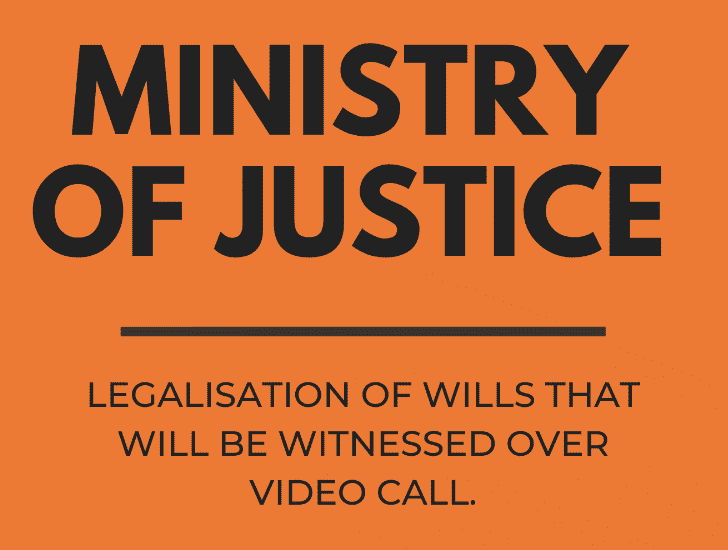Will Witnessing by video call from September has just been announced. It’s been made official from the MOJ and The Institute of Professional Willwriters.
Amendment to Wills Act
“The M.O.J have declared the amendment to the Wills Act 1837, enabling Wills to be witnessed via online video as of September, using platforms such as Skype and Zoom- which we have all become accustomed to over the last couple of months.
Retrospective will witnessing by video call
It also provides legal cover to those who have used video witnesses prior to this event (retrospective of the 31st of January).
Temporary legislation
One thing to note is this new legislation is only temporary (until January 2022). However, this may be extended if it is believed necessary and the Wills produced in this time will only be valid if the guidelines have been followed.”
Find out more
To read the official article please use the link below:
We are delighted that it will soon be possible to implement will witnessing by video call.
Contact us for more information.
Extract from MOJ website;
Distanced witnessing – ‘clear line of sight’
In the existing law a witness must have a ‘clear line of sight’ of the will-maker signing and understands that they are witnessing and acknowledging the signing of the document, for example if self-isolation or social distancing have prevented the signing and witnessing of a will by people in the same room.
The person making the will must have a clear line of sight of the witnesses signing the will to confirm they have witnessed the will-maker’s signature (or someone signing on their behalf and at their direction).
The following scenarios would lead to a properly executed will during the pandemic within the existing law, provided that the will maker and the witnesses each have a clear line of sight:
- witnessing through a window or open door of a house or a vehicle
- witnessing from a corridor or adjacent room into a room with the door open
- witnessing outdoors from a short distance, for example in a garden
Video-witnessing
In the new law, all of the legislation set out above applies where a will is video-witnessed.
The type of video-conferencing or device used is not important, as long as the person making the will and their two witnesses each have a clear line of sight of the writing of the signature.
To reflect this, the will-maker could use the following example phrase:
‘I first name, surname, wish to make a will of my own free will and sign it here before these witnesses, who are witnessing me doing this remotely’.
Witnessing pre-recorded videos will not be permissible – the witnesses must see the will being signed in real-time. The person making the will must be acting with capacity and in the absence of undue influence. If possible, the whole video-signing and witnessing process should be recorded and the recording retained. This may assist a court in the event of a will being challenged – both in terms of whether the will was made in a legally valid way, but also to try and detect any indications of undue influence, fraud or lack of capacity.
The following scenarios illustrate circumstances in which video-witnessing might be appropriately used:
Example 1:
the testator (T) is alone and witness one (W1) is physically present with witness two (W2). Together, W1 and W2 are on a two-way live-action video-conferencing link with T
Example 2:
T, W1 and W2 are all alone in separate locations and are connected by a three-way live-action video-conferencing link.
Example 3:
T is physically present with W1, and they are connected to W2 by a two-way live-action video-conferencing link.
Example 4:
T is physically present with a person signing the will on their behalf (and at their direction), and connected to W1 and W2 by two or three-way live-action video-conferencing (depending on whether W1 and W2 are in the same or separate locations)
Signing and witnessing a will by video-link
Signing and witnessing by video-link should follow a process such as this:
Stage 1:
- The person making the will ensures that their two witnesses can see them, each other and their actions.
- The will maker or the witnesses should ask for the making of the will to be recorded
- The will maker should hold the front page of the will document up to the camera to show the witnesses, and then to turn to the page they will be signing and hold this up as well.
- By law, the witnesses must see the will-maker (or someone signing at their direction, on their behalf) signing the will. Before signing, the will-maker should ensure that the witnesses can see them actually writing their signature on the will, not just their head and shoulders.
- If the witnesses do not know the person making the will they should ask for confirmation of the person’s identity – such as a passport or driving licence.
Stage 2:
The witnesses should confirm that they can see, hear (unless they have a hearing impairment), acknowledge and understand their role in witnessing the signing of a legal document. Ideally, they should be physically present with each other but if this is not possible, they must be present at the same time by way of a two or three-way video-link.
Stage 3:
- The will document should then be taken to the two witnesses for them to sign, ideally within 24 hours. It must be the same document (see Counterpart documents).
- A longer period of time between the will-maker and witnesses signing the will may be unavoidable (for example if the document has to be posted) but it should be borne in mind that the longer this process takes the greater the potential for problems to arise.
- A will is fully validated only when testators (or someone at their direction) and both witnesses have signed it and either been witnessed signing it or have acknowledged their signature to the testator. This means there is a risk that if the will-maker dies before the full process has taken place the partly completed will is not legally effective.
Stage 4:
The next stage is for the two witnesses to sign the will document – this will normally involve the person who has made the will seeing both the witnesses sign and acknowledge they have seen them sign.
- Both parties (the witness and the will maker) must be able to see and understand what is happening.
- The witnesses should hold up the will to the will maker to show them that they are signing it and should then sign it (again the will maker should see them writing their names, not just see their heads and shoulders).
- Alternatively, the witness should hold up the signed will so that the will maker can clearly see the signature and confirm to the will maker that it is their signature. They may wish to reiterate their intention, for example saying: “this is my signature, intended to give effect to my intention to make this will”.
- This session should be recorded if possible.
Stage 5:
- If the two witnesses are not physically present with each other when they sign then step 4 will need to take place twice, in both cases ensuring that the will maker and the other witness can clearly see and follow what is happening. While it is not a legal requirement for the two witnesses to sign in the presence of each other, it is good practice.
Consideration may be given to the drafting or amending of the attestation clause in a will where video-witnessing is used. The attestation clause is the part of the will that deals with the witnessing of the will makers signature. For video-witnessed wills it may be advisable to mention that virtual witnessing has occurred, along with details of whether a recording is available.
Electronic signatures
The Government has decided not to allow electronic signatures as part of this temporary legislation due to the risks of undue influence or fraud against the person making the will. These risks were identified by the Law Commission in its 2017 consultation paper on wills. The Law Commission is undertaking a law reform project which will include consideration of the possibility of allowing electronic wills in the future.


